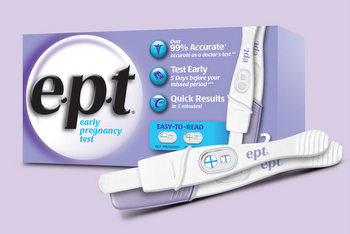
That glorious moment of peeing on a stick and getting the answer you crave. A positive. Two lines. Or in some cases, a plus sign or a digital “yes” or “pregnant.” Have you ever wondered how anyone got the brilliant idea of an in-home laboratory test?
Long, long ago
The first recorded pregnancy tests were discovered in ancient Egyptian texts dating back to 1350 BCE. A woman who suspected pregnancy was to water seeds of barley and wheat over a week or so. The text states, “If the barley grows, it means a male child. If the wheat grows, it means a female child. If both do not grow, she will not bear at all.” They may have been on to something — later testing revealed that 70 percent of the time, a pregnant mom’s pee will show growth, whereas the urine of a non-pregnant woman would not.
Hormones and bunnies

In the 1890s, scientists were describing certain “secretions” within the body that they felt were crucial to our inner workings — later to be known as hormones. In the 20s, scientists in several countries were independently observing that when the urine of pregnant women was injected into immature mice, rabbits, frogs and toads, it would create changes in the animals’ ovaries . Thus began the phrase “the rabbit test” — the rabbit was euthanized and dissected to determine pregnancy, because the hCG present in a pregnant woman’s urine induced ovulation in these critters.
It gets more complicated
In the 1960s, there was even more research done and a “hemagglutination inhibition test” was developed. This sounds terribly complicated, and it was — it was a lab test that used purified hCG that was mixed with a urine sample along with antibodies directed against hCG. If a woman was pregnant, the red cells clumped together in a particular pattern.
And then more simple
Pregnancy testing became easier for users in the 70s, with a test that would display results in as little as two hours, and would even work as early as four days after a missed period. Yes, it was still required to be run in a laboratory by a trained technician, but things were approaching home use faster than ever before.
The first pregnancy test marketed in the United States for home use was e.p.t. — a brand that is widely known and still used today. This year marks the 35th anniversary of the e.p.t. home pregnancy test — it was introduced in 1977 and had quite a number of ingredients in each package. An advertisement that ran in Mademoiselle that year reported that it included “pre-measured ingredients consisting of a vial of purified water, a test tube containing, among other things, sheep red blood cells… as well as a medicine dropper and clear plastic support for the test tube, with an angled mirror at the bottom.”
Bringing this laboratory test into the privacy of the home allowed women to learn sooner, and in the privacy of their own home, the potentially life-changing news that she was expecting. It also helped her make changes earlier, if needed, to her lifestyle — such as improving her diet or quitting smoking.
Today

Today’s pregnancy tests have advanced leaps and bounds from this early home pregnancy test — and e.p.t. continues to offer home pregnancy tests, but with nothing to mix, no two-hour wait and no high price tag. You can get simple and accurate pregnancy tests for as little as one dollar on some brands, and you can get even cheaper tests over the internet. They can often detect pregnancy several days before a missed period, and only take minutes to tell us the answer.
The first digital tests appeared in 2003 and we can only imagine how much easier, cheaper and faster pregnancy tests will be when our children are having babies.
More on pregnancy testing
4 Tips to consider before taking a home pregnancy test
How to take a pregnancy test
Top 8 signs you are pregnant
